The table slide is a deceptively simple yet essential component in almost every well-crafted Amish dining table. These mechanisms not only support the table’s structure and function but also ensure that adjusting its size is a smooth, seamless experience.
Key Takeaways
- Table slides come in three main types: wooden, geared, and ball-bearing.
- Table slides play a vital role in supporting the Amish tradition of communal gatherings, allowing tables to extend quickly to accommodate neighbors and guests.
- Wooden slides offer strength and a traditional look, geared slides ensure smooth adjustments, and ball-bearing slides provide effortless movement for heavy use.
- The right table slide should complement the overall design of the furniture, enhancing usability without compromising style.
Each type of table slide can enhance your dining experience and meet your home’s distinctive needs. Read on to learn more about wooden, geared, and ball-bearing slides.
What Are Table Slides?
Table sliders, also known as table extension slides or extension mechanisms, are specialized tracks that enable smooth extension and contraction of dining tables. They essentially function like drawers, but designed specifically to support the weight and stability of a tabletop.
Here’s a breakdown of their key functions:
- Increased Seating Capacity: By incorporating sliders, a dining table can transform from a cozy size to one that comfortably seats more people. This is achieved by allowing a section of the tabletop, or “leaves,” to slide out on the tracks, creating extra surface area.
- Effortless Operation: Sliders are designed for easy use. They often incorporate features like ball bearings or a rack and pinion mechanism to ensure smooth gliding motion when extending or collapsing the table.
- Stability and Balance: Quality table sliders are built to ensure the extended table remains stable and level, even when supporting a significant amount of weight from diners and tableware.
In Amish furniture, sliders maintain the balance of style and functionality, ensuring that tables extend with precision and ease while retaining their timeless aesthetic appeal.
Significance of Table Slides for the Amish
For the Amish, life revolves around community and togetherness, with frequent large gatherings centered around meals and religious services.
“Group singings, barn raisings, ‘sisters days,’ ‘work bees’ (sometimes called frolics), and similar activities are important social events that blend together work and leisure or, in the case of singings, leisure and worship, in most Amish communities,” as published in Amish Studies by Young Center for Anabaptist and Pietist Studies at Elizabethtown College. “Such activities within church districts and sometimes across districts weave leisure into the larger social and spiritual framework.”
Extendable Amish tables with durable slides quickly transform dining table sizes into large banquet configurations, comfortably accommodating more people from their community.
This practical feature enhances the functionality of Amish dining spaces and aligns with their cultural emphasis on hospitality and community bonding. Expanding a dining area on demand is invaluable in Amish homes, where hosting large family gatherings or community events is an integral part of their culture.
Moreover, the Amish commitment to durability and handcrafted quality ensures these table slides are built to last, embodying the principles of sustainability and craftsmanship revered in their community.
Different Types of Table Slides
Traditional wooden sliders and modern metal sliders are two main types of table slides used in Amish furniture. Wooden sliders, crafted from hardwoods like oak, cherry, and maple, offer a cohesive, all-wood aesthetic. Modern metal sliders, often made from aluminum or steel, provide superior functionality and a more contemporary look.
Traditional Wooden Sliders
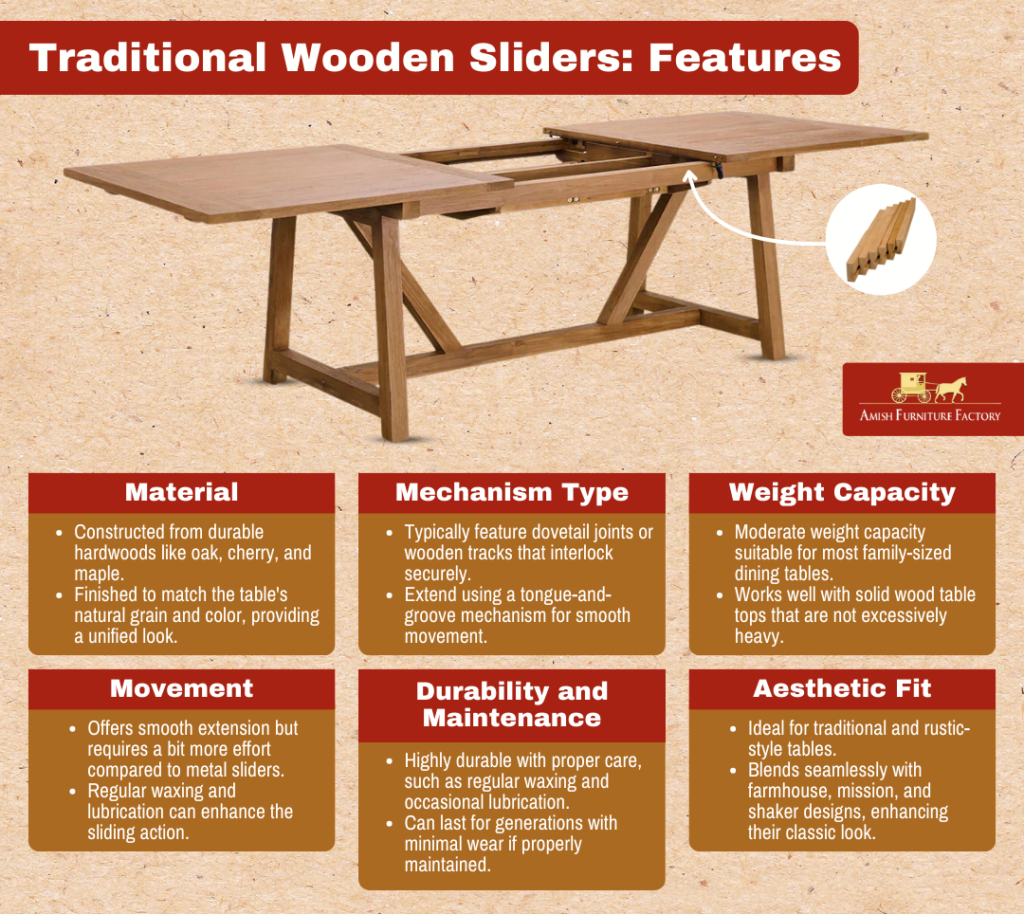
Traditional wooden sliders are a hallmark of Amish craftsmanship, embodying the timeless appeal and quality associated with Amish furniture. These sliders are designed to complement traditional Amish tables, offering a cohesive all-wood appearance that blends seamlessly with the table’s natural aesthetic. Here’s a closer look at their features:
Geared Slides
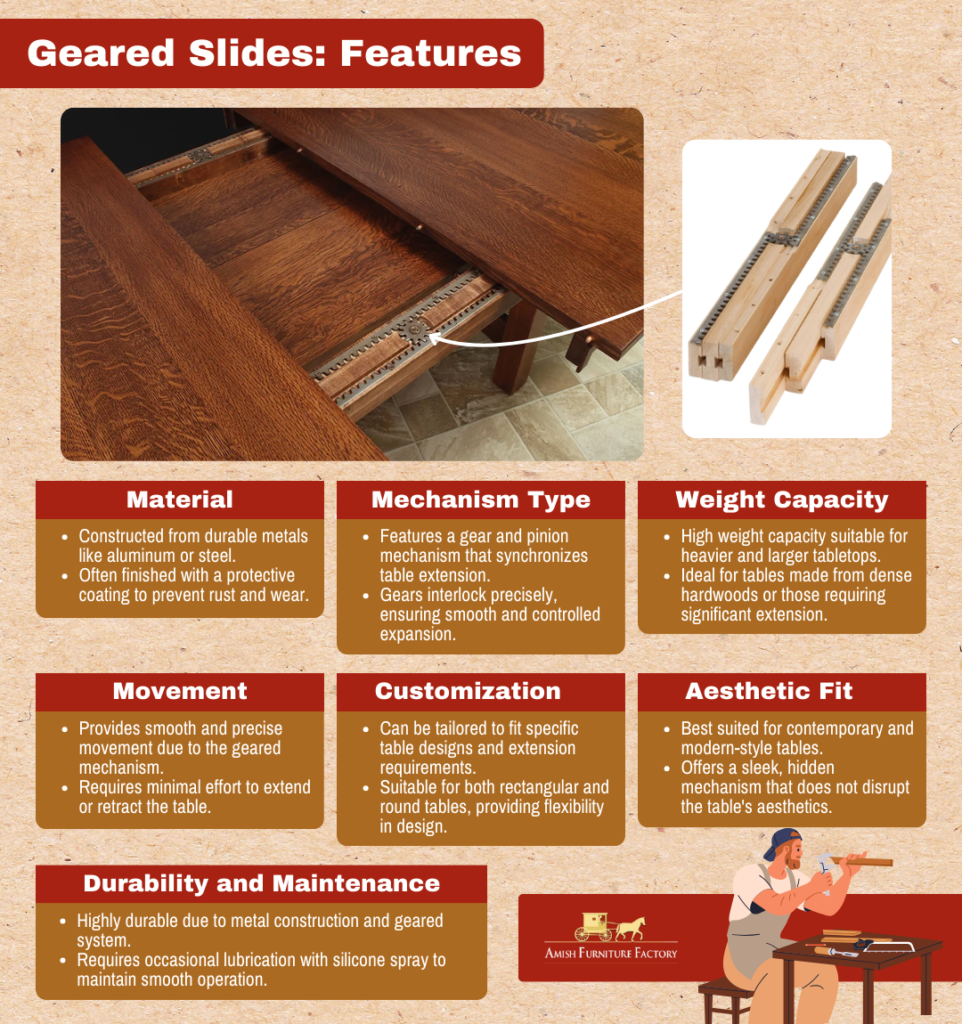
Geared slides are a modern solution that combines functionality and precision, making them a popular choice for Amish tables. These slides employ a gear and pinion system that ensures smooth, accurate movement, allowing tables to expand effortlessly. Here are some key features:
Ball Bearing Slides
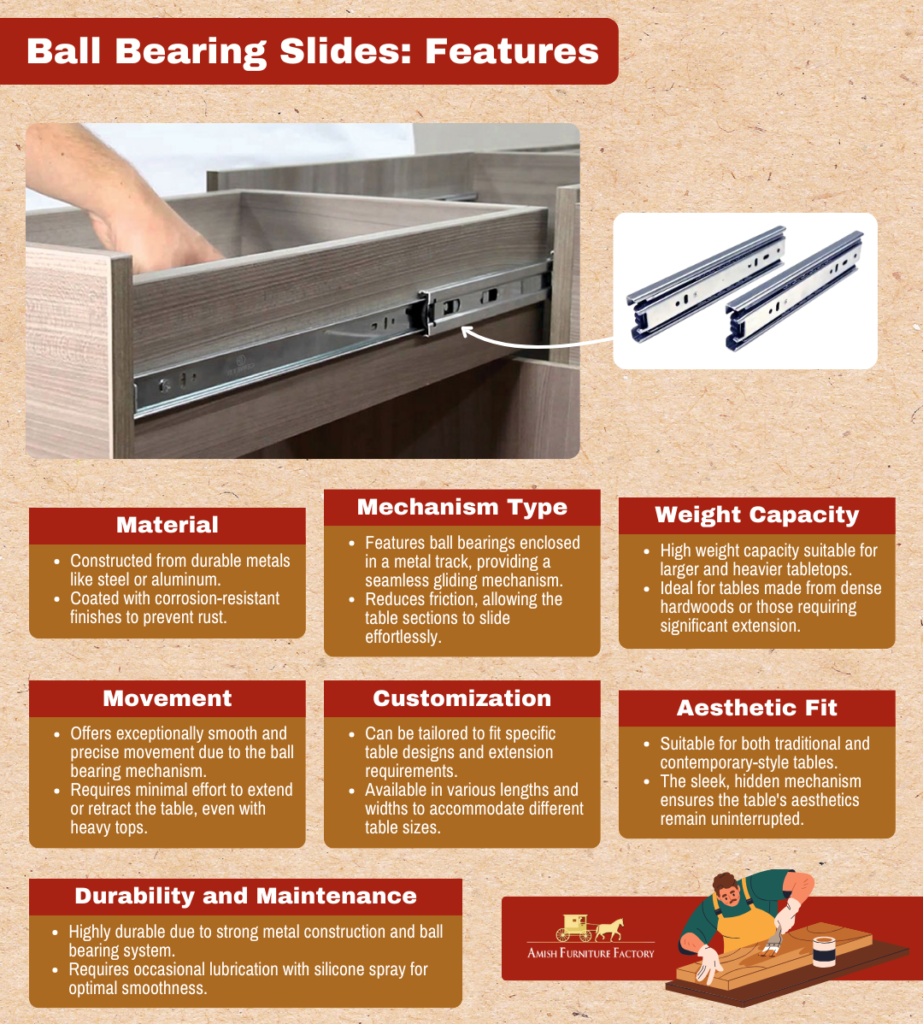
Ball bearing slides are a modern solution that offers superior smoothness and precision for extendable tables. They are particularly popular in Amish tables due to their high load capacity and effortless movement. Here are some key features:
Benefits of Using Table Slides
Table slides provide a practical solution for maximizing a table’s functionality without compromising style. One key benefit is the increased seating capacity they offer.
With a simple slide mechanism, tables can easily extend to accommodate more guests, making them ideal for family gatherings, parties, and community events. When not in use, tables can be retracted to save space in the dining area, a feature particularly valuable for homes with limited space.
Ease of use is another significant advantage, as modern table slides offer smooth, effortless movement, even with heavier table tops. This makes extending and retracting tables quick and easy. Despite their simplicity, table slides provide excellent durability and stability. Made from high-quality materials like wood, steel, or aluminum, they can withstand daily use while preventing wobbling or uneven surfaces.
Customization is also a strong feature of table slides, as they come in various lengths, widths, and materials to match specific table designs. Whether the table style is traditional or contemporary, the slides can be tailored accordingly. They seamlessly integrate with the table’s design, enhancing functionality without compromising style.
Selecting the Right Slide for Your Table
The right table slide should enhance your table’s functionality while preserving the beauty and integrity of the furniture’s craftsmanship. You can not just sacrifice one for the sake of the other.
By carefully considering these factors, you can select a slide that perfectly suits your table, ensuring that it remains a cherished piece for gatherings and family meals for years to come.
Here’s a detailed comparison of the different types of table slides for your reference:
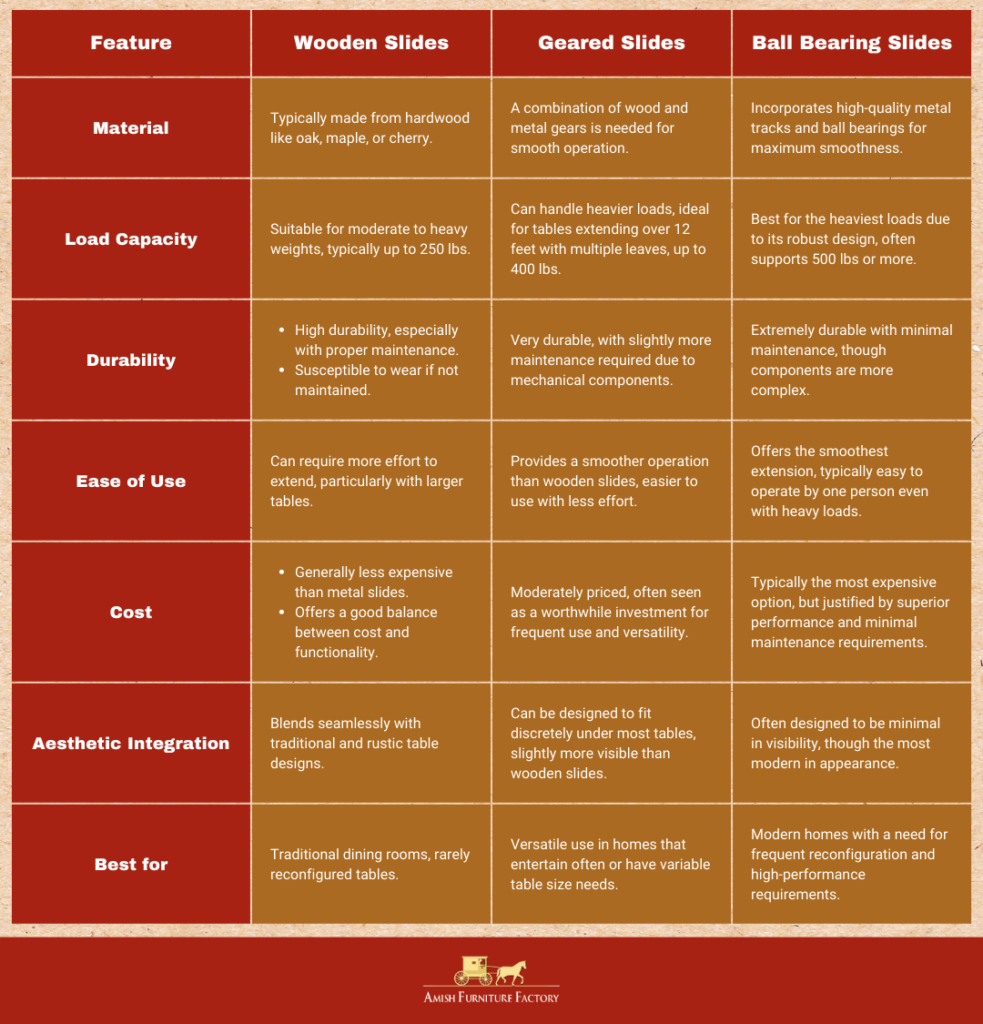
Matching the Slide to Your Table Type
Selecting the appropriate slides for your table is crucial. Traditional wooden slides provide strong support, making them ideal for tables that do not require frequent adjustments. For tables with unique weight distributions or a single central support, opt for geared or ball-bearing slides. These are specifically designed to ensure stability and smooth operation.
Choosing the Right Material
Wooden slides are best for tables that will remain extended for long periods or where aesthetic coherence with traditional styles is essential. Metal slides (geared or ball bearing) are preferable for tables that need frequent and easy adjustments. They are also more suitable for supporting heavier loads efficiently.
Considering Load Capacity
Always check the slides’ weight capacity rating. If your fully loaded table (including the tabletop, leaves, and any items that may be placed on top during use) is estimated to weigh 200 pounds, select slides rated for at least 250 pounds or more to provide a safe margin. This prevents any structural compromises that could lead to damage or failure of the mechanism.
Aesthetic Compatibility
Ensure the slides are visually compatible with your table. Invisible or minimally visible mechanisms are ideal for maintaining the table’s aesthetic appeal. Choose slides that blend in under your tabletop or along the inner rails where they are less intrusive.
Choose slides that match the color of your table’s underside or framing. For example, if your table is made from cherry wood, opt for slides finished in a similar stain or paint that blends when viewed from a distance or under the table.
If standard slides do not perfectly match your needs, consider custom options. Many manufacturers, like us, offer custom finishes or designs that can be tailored to your specific requirements.
Operational Ease
Determine who will be using the table and choose a slide type accordingly. If ease of use is a priority:
- Single-person operation: Ball-bearing slides are recommended for their smooth mechanics and minimal effort required.
- Multi-person setup: Wooden or heavier geared slides might be acceptable if minor lifting and setting are not inconveniences.
Maintenance Needs
Regularly check for any signs of wear or environmental damage, such as warping or swelling from humidity. Periodic application of a suitable wood conditioner is necessary to maintain smooth operation.
For metal slides, periodically clean and lubricate metal components to prevent rust or corrosion, especially in humid environments. This maintenance helps keep the operation smooth and extends the slide’s lifespan.
Installation and Maintenance of Table Slides
Installing and maintaining table slides is crucial to ensuring that your dining table functions smoothly and lasts through many years of family gatherings and social events. A dining table is not just a piece of furniture but a place for friends and family to gather.
Step-by-Step Installation Process
- Prepare the Area: Before beginning the installation, ensure your workspace is clean and spacious enough to accommodate the table and all necessary tools. Lay down a protective cloth to prevent scratches on the table’s surface.
- Attach the Slides: Start by aligning the slides precisely on the underside of the table. They must be parallel to each other to ensure smooth operation. Use a measuring tape and a level to confirm alignment.
- Secure the Slides: Once aligned, secure the slides using screws or bolts provided by the manufacturer. It’s important not to overtighten these fasteners, as this could strip the wood or deform the metal slides.
- Test the Mechanism: Before fully reassembling the table, test the slide mechanism by extending and retracting it several times. This check will allow you to ensure that the slides are not only installed correctly but also operating smoothly.
- Double-Check Alignment: Always double-check the alignment of the slides. Even a slight misalignment can cause the table to extend unevenly or jam.
- Use Quality Fasteners: Invest in high-quality screws or bolts that can handle the weight and repeated motion. This will help prevent the slides from loosening over time.
Conclusion
In Amish furniture, table slides are essential for maximizing the versatility and functionality of well-crafted dining tables. They ensure seamless adjustments, allowing tables to expand and contract effortlessly to accommodate gatherings of all sizes.
Choosing the right table slide not only enhances the table’s physical structure but also supports the Amish principles of hospitality, craftsmanship, and sustainability.
Whether you prefer the traditional wooden slides or the modern ball-bearing mechanisms, each option brings value and timeless functionality to your dining experience. By carefully selecting the appropriate slide type, you can ensure that your Amish table remains a cherished centerpiece for family meals and gatherings for generations to come.
Frequently Asked Questions
What is the best lubricant for table slides?
For wooden slides, a small amount of furniture wax or a similar wood-friendly lubricant can be applied sparingly to the slide tracks. For metal slides, such as ball bearing or geared slides, use a dry silicone spray or graphite lubricant. These lubricants will not attract dust and debris, which can clog the mechanism.
Should slides be bigger or smaller?
The table slide size should be slightly longer than the maximum extension length you need. This ensures they can support the table fully when extended without overstressing the slides. Additionally, ensure the slides have a suitable load rating to handle the table’s weight plus any additional load from use.
Can you use silicone spray on wood?
Using silicone spray on wood is generally not recommended. While silicone spray is excellent for metal and plastic components because it repels moisture and dust, it can create a slippery surface on wood and potentially harm the finish.
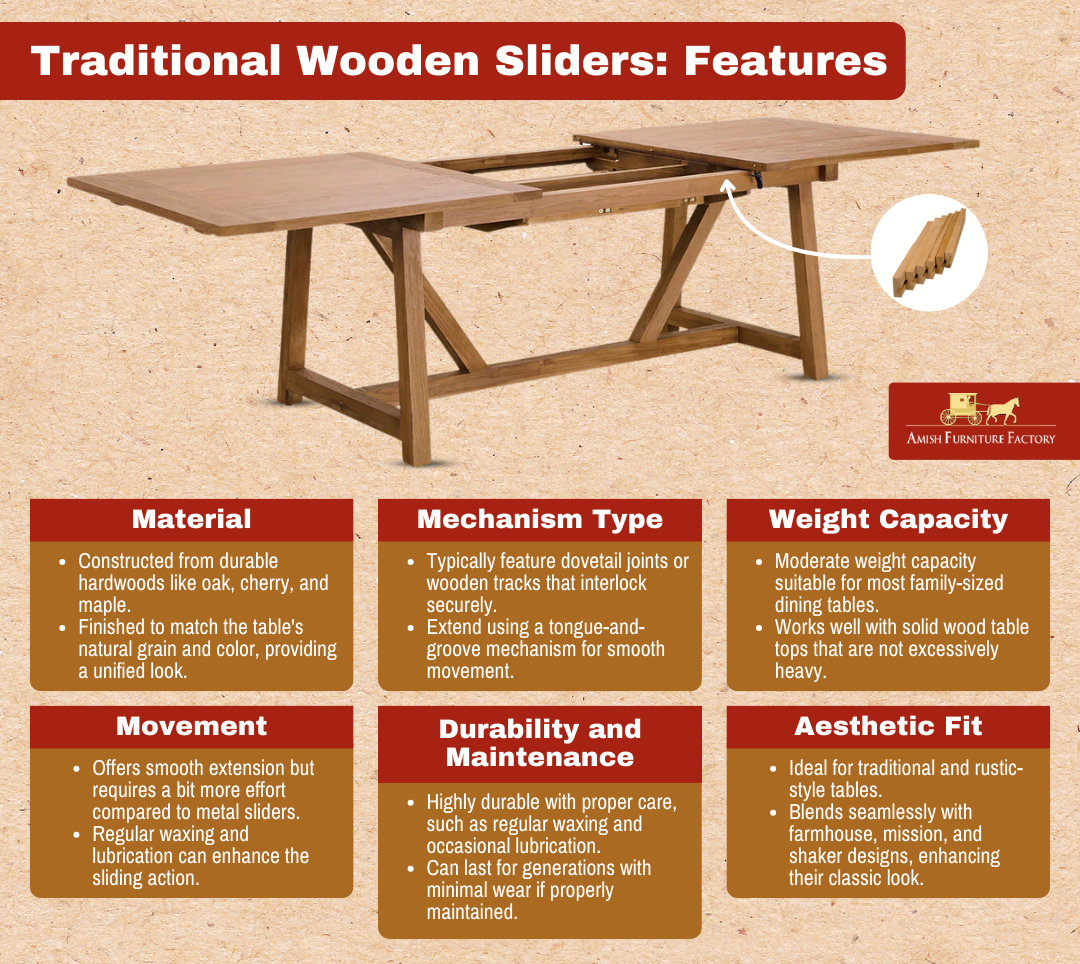
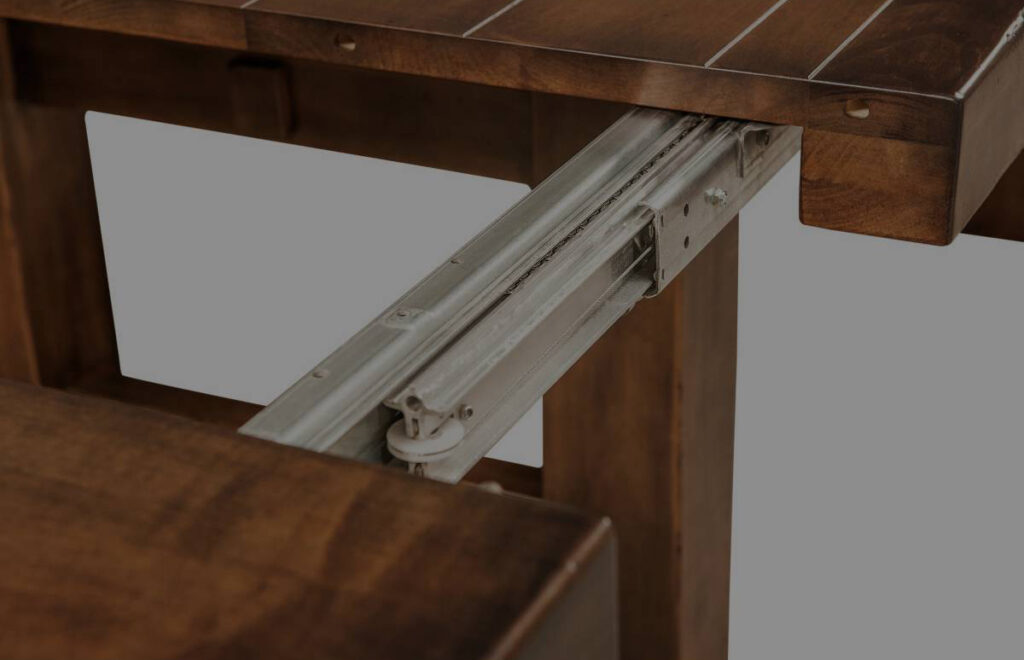
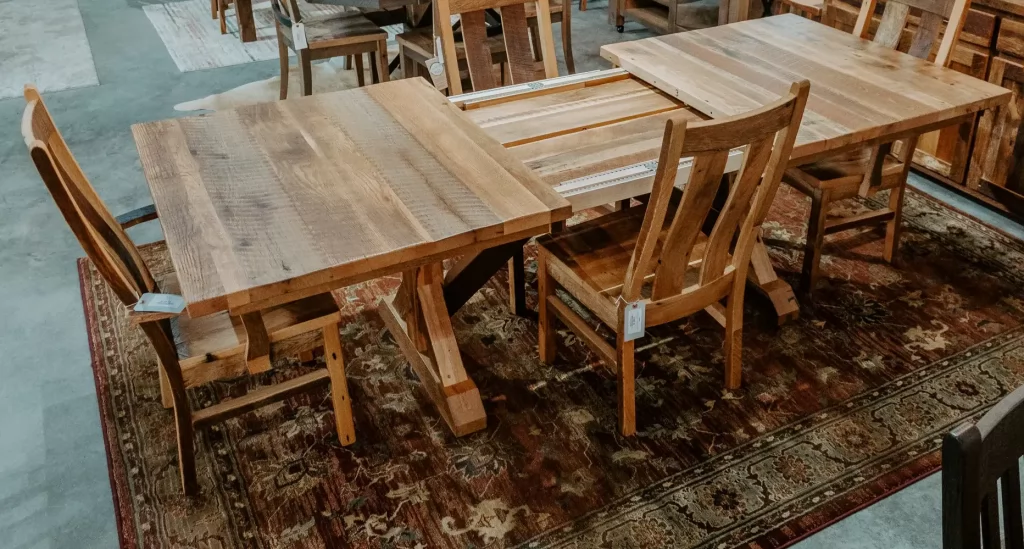
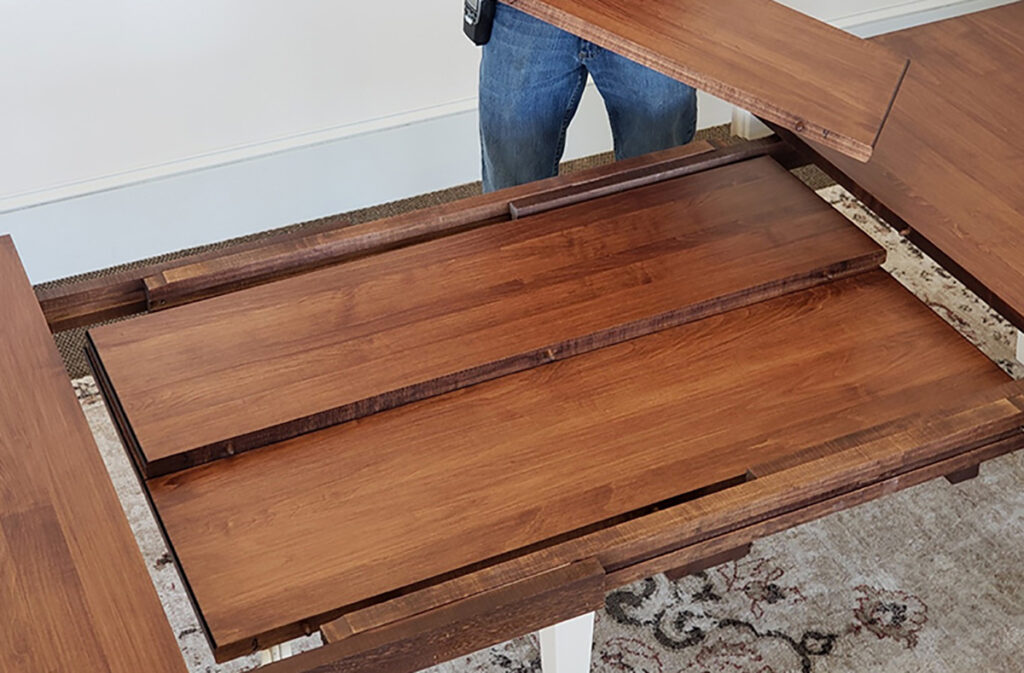
I am interested in ordering a table. I have one but it is too small wanting a larger one and chairs.
I have an antiques 5 leg oak table that has an extension slide that has worn out that enables me to get a 120″ opening enabling me to insert 5 two foot extension board. I would like to replace it. Do you manufacture a slide that can meet my needs
Two extension gear type slides broke. Will you sell me a pair of the wooden slides?
How does the use of ball bearing slides in a table top design contribute to ease of operation and prevent binding between the two table top halves, and what makes the sound of rolling metal balls inside the slide rail casing appealing in this context?
We have a dining room table with geared slides. The table will not open the last inch so that we can install the last leaf. When we tried to close the table it wouldn’t close completely. We removed the gears so that we could close the table. How do we fix this?
I’d also like to know
Can I but the plan of the table sown in the video? Will it be able to extend for a total of 14 feet